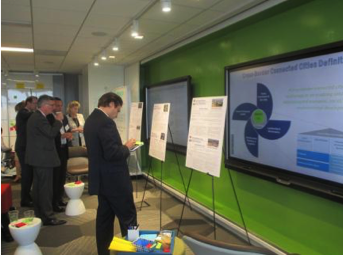Realizing The Border Dividend: Smart City Pairs Can Transform U.S.-Mexico Border Communities

Who will you meet?
Cities are innovating, companies are pivoting, and start-ups are growing. Like you, every urban practitioner has a remarkable story of insight and challenge from the past year.
Meet these peers and discuss the future of cities in the new Meeting of the Minds Executive Cohort Program. Replace boring virtual summits with facilitated, online, small-group discussions where you can make real connections with extraordinary, like-minded people.
Project teams from Deloitte and Cisco have explored how a SMART Cities Framework might be applied to transform the operation of the U.S.-Mexico border and collaborated with the Barcelona City Council in developing a framework to measure SMART City program performance. At the core of these efforts is understanding the impact that technology (such as broadband, City WiFi, and Open Data), enhanced governance and planning, and performance monitoring can have on communities, increasing economic output, job creation, and quality of life. Here we discuss how applying a SMART Cities Framework could transform the border, yielding a potential “Border Dividend” for communities both in the U.S. and Mexico.
A Border Challenge – and Opportunity
The U.S.-Mexico Border stretches nearly 2,000 miles from the Pacific Ocean to the Gulf of Mexico. It is among the largest trade zones in the world, with an estimated $1.4 billion dollars of commerce and 1 million people crossing the border daily. There are deep historical, cultural, and economic ties that bind U.S. and Mexican border communities and support millions of jobs through bilateral trade
Despite the geographic proximity of U.S. and Mexican border communities, there are stark differences on each side of the border, including different levels of development. U.S. border cities’ per capital income and broadband access rates, for example, are substantially higher than their counterparts in Mexico. Although they are improving, waiting times for people and goods entering the U.S. continue to be a source of concern for industry and communities on both sides of the border. Cross-border economic development opportunities are not as fully exploited as they could be, often putting pressure on already overburdened city infrastructure on the U.S. side. Border city pairs tend to face away from each other, rather than embracing their proximity and the border as in their common interest.
Given the dramatic and graphic increase in drug-related criminal activities along the U.S.-Mexico Border in recent years, much of the recent public narrative around the border has been focused on the issues of illegal immigration, security and terrorism threats, and increased border enforcement. This has overshadowed recent trends such as zero net migration and increased cooperation by the U.S. and Mexico governments in Trusted Traveler programs, inspection programs, and local collaboration through alliances and associations, such as the Borderplex Alliance and Border Trade Alliance.
In recognition of these challenges, the U.S. and Mexican governments and private sectors have come together to explore potential opportunities to jointly improve practical approaches to the U.S.-Mexico Border. In May 2013, U.S. President Barack Obama and Mexican President Peña Nieto announced the creation of the High Level Economic Dialogue (HLED) between the public and private sectors on both sides of the U.S.-Mexico Border with the objective of advancing measures to promote mutual economic growth, job creation, and the global competitiveness of North America. As part of the HLED, U.S. and Mexican business leaders began to explore under a U.S.-Mexico CEO Dialogue how a Smart Cities Framework might be applied to transform the operation of the U.S.-Mexico border and improve economic and social conditions for nearby communities. A Transformation Working Group, chaired by Cisco and supported by Deloitte as an advisor, developed the Cross Border Connected Cities (CBCC) Concept, articulating a broader vision for border operations within an urban planning and Smart City context.
 The Transformation Working Group convened more than 30 global private sector partners and public sector entities involved in border commerce and management. Using innovative means of meeting facilitation such as Deloitte Greenhouse Workshops in the U.S. and Mexico, the Working Group hypothesized a new approach to the border: one beyond the traditional transactional-focused approach to a wider city border pair-based approach. This wider approach could result in substantial economic benefits being realized – a potential “Border Dividend.” The Working Group estimated that the application of the CBCC concept could yield economic benefits of between five to ten times the investment required. For a typical border city pair the estimated annual direct benefits in applying the CBCC Concept could amount to almost $1 billion in increased annual regional output, up to $40 million in reduced annual carrier costs for goods, and up to 4,000 new sustained jobs in the region where the city pair is located.
The Transformation Working Group convened more than 30 global private sector partners and public sector entities involved in border commerce and management. Using innovative means of meeting facilitation such as Deloitte Greenhouse Workshops in the U.S. and Mexico, the Working Group hypothesized a new approach to the border: one beyond the traditional transactional-focused approach to a wider city border pair-based approach. This wider approach could result in substantial economic benefits being realized – a potential “Border Dividend.” The Working Group estimated that the application of the CBCC concept could yield economic benefits of between five to ten times the investment required. For a typical border city pair the estimated annual direct benefits in applying the CBCC Concept could amount to almost $1 billion in increased annual regional output, up to $40 million in reduced annual carrier costs for goods, and up to 4,000 new sustained jobs in the region where the city pair is located.
The Cross Border Connected City — Technology and Governance at the Heart of Border Region Transformation
The resulting Cross Border Connected Cities concept involves four key components: (i) Creation of a Transformation Zone; (ii) Strategic Bundling of Programs; (iii) Development of a Governance Structure and Challenge Process; and (iv) Technology Architecture.
The Transformation Zone would extend across the border, encompassing a U.S.-Mexico city pair and the hinterlands along a larger development corridor. The Zone would include three integrated areas: a Border Optimization Area, a City Planning Area, and a Regional Planning Area. The Zone would apply a Smart City Concept, incorporating a backbone of cross border technology infrastructure, and a set of bundled programs and initiatives, as well as a dedicated governance structure.
The Strategic Bundling of Programs and initiatives would improve the performance of initiatives currently being undertaken on a less coordinated basis. Five immediate initiatives were selected to potentially be part of the CBCC concept through stakeholder consultations and workshops:
- Expanded Pre-Border Goods Clearance Programs
- Expanded Pre-Border Personnel Clearance Programs
- Integrated Trade Database
- Integrated City/Spatial Planning
- Binational Governance
A Transformation Task Force composed of private and public sector leaders from both sides of the border would champion the effort and coordinate stakeholder actions on both sides of the border. It would have political backing, a defined charter, public and private stakeholder representation, and financial support. It would oversee implementation of an action plan for each program/initiative and monitor progress against key performance indicators (KPIs). It would track implementation progress and use technology (virtual of the technology master meeting rooms, Cloud-based systems) in fulfilling its mandate. The Task Force would also report back to the CBCC stakeholders, and undertake any advocacy required to remove obstacles or alter direction as the concept unfolds.
Finally, Technology is the foundational enabler for improvements in all components of border management within the “Transformation Zone.” The layering of physical, network, application, and cross-cutting technologies would support significant improvements in border management and help facilitate economic growth, security benefits, environmental controls, and effective management of public and private resources. There would be ubiquitous broadband connectivity; IP-based, secure connectivity to enable ICT, Command and Control Centers, Video Surveillance / Analytics, RFID and Asset Tracking, Traffic Control, and SMART Kiosks / Bio-Metrics. E-clearance stations would enable the physical border to be pushed back along dedicated technology-enabled and -secured transportation corridors, freeing up previously unavailable development areas.
In Pursuit of the Border Dividend: The Way Forward
One of the most important next steps for moving the CBCC Concept forward is the formation and funding of the Transformation Task Force. Once formed, the Task Force will work with public champions from both sides of the border to secure funding and program commitments to advance the deployment of the CBCC Concept. It will oversee a challenge process to select a city pair to pilot the CBCC Concept. Once a city pair is selected, the Task Force will support the establishment of a city pair Transformation Unit to oversee city-level implementation of the pilot program.
About the Authors:
 Tom Galizia is a principal at Deloitte Consulting LLP, based in San Francisco, CA. Tom is Deloitte Consulting’s national leader for the Technology Strategy and Architecture practice that develops IT strategies for business outcomes, drives efficient IT operations, evolves key IT capabilities to meet changing market dynamics and delivers IT-enabled business transformation. Tom’s most recent work focuses on cloud enablement, making the internet of things real, and AGILE transformations. With 23 years in consulting, Tom has significant experiences as a leading technology, strategy and operations improvement professional. He has served high tech clients in the areas of Go-to-Market/industry vertical solutions, emerging market growth, new business models, M&A/divestiture, services delivery, global supply chain, and finance transformation. He has worked extensively throughout North America and Europe and led emerging markets projects in Mexico, Brazil, India and China. In tougher market environments, Tom brings significant experience in the areas of restructuring/cost reduction, project rationalization and business consolidation/ model transformation. While based in London, he drove major near shoring and off shoring/outsourcing programs for global clients and published research in this area. Tom has recently published articles on ‘Ambient Computing,’ ‘CIO as a Venture Capitalist, Total Cost of Ownership: Single Vendor vs. Multivendor,’ ‘Gold Rush: The Scramble to Claim and Protect Value in the Digital Age,’ ‘Amplifying Social Signals’ and ‘Staple Yourself to the Customer.’ Tom drives many of Deloitte’s community service initiatives, including a study on renewable energy/sustainability for The Tech Museum in San Jose and growth strategy for UC Berkeley’s Lawrence Hall of Science. Tom earned his M.B.A. from Harvard Business School with honors and a B.A. from Hamilton College with honors. Contact Tom here.
Tom Galizia is a principal at Deloitte Consulting LLP, based in San Francisco, CA. Tom is Deloitte Consulting’s national leader for the Technology Strategy and Architecture practice that develops IT strategies for business outcomes, drives efficient IT operations, evolves key IT capabilities to meet changing market dynamics and delivers IT-enabled business transformation. Tom’s most recent work focuses on cloud enablement, making the internet of things real, and AGILE transformations. With 23 years in consulting, Tom has significant experiences as a leading technology, strategy and operations improvement professional. He has served high tech clients in the areas of Go-to-Market/industry vertical solutions, emerging market growth, new business models, M&A/divestiture, services delivery, global supply chain, and finance transformation. He has worked extensively throughout North America and Europe and led emerging markets projects in Mexico, Brazil, India and China. In tougher market environments, Tom brings significant experience in the areas of restructuring/cost reduction, project rationalization and business consolidation/ model transformation. While based in London, he drove major near shoring and off shoring/outsourcing programs for global clients and published research in this area. Tom has recently published articles on ‘Ambient Computing,’ ‘CIO as a Venture Capitalist, Total Cost of Ownership: Single Vendor vs. Multivendor,’ ‘Gold Rush: The Scramble to Claim and Protect Value in the Digital Age,’ ‘Amplifying Social Signals’ and ‘Staple Yourself to the Customer.’ Tom drives many of Deloitte’s community service initiatives, including a study on renewable energy/sustainability for The Tech Museum in San Jose and growth strategy for UC Berkeley’s Lawrence Hall of Science. Tom earned his M.B.A. from Harvard Business School with honors and a B.A. from Hamilton College with honors. Contact Tom here.
 Jim O’Gara is a director at Deloitte Transactions and Business Analytics LLP in the Civilian Sector, focused on Emerging Markets, based in Washington, DC. He has over 30 years of experience working on the design, construction, operation, and management of large-scale capital programs on behalf of public and private sector clients worldwide. His experience includes designing, developing, and managing integrated regional and municipal development projects, cities, industrial estates, free zones, technology parks, free ports, and tourism areas that aim at removing administrative barriers, attracting foreign direct investment, facilitating trade, and expanding business activities. Jim has successfully implemented large-scale projects in over 25 countries in the past decade with assignments ranging from feasibility studies, to legislative reforms, master planning, management and implementation support, capacity building, developing institutional arrangements, and strategic planning. A civil engineer with an M.B.A., Jim also has experience in formulating and executing public-private partnerships (PPPs) in a wide variety of urban development projects. In Jordan, he led the successful conceptualization and development of a US$ 2 billion special economic zone in Aqaba. Earlier in his career, he held senior positions in the capital development and marketing functions of Ireland’s leading regional development agency, Shannon Development. Jim earned his M.B.A. from the University of Limerick and his B.S. in Civil Engineering from the National University of Ireland in Galway. Contact Jim here.
Jim O’Gara is a director at Deloitte Transactions and Business Analytics LLP in the Civilian Sector, focused on Emerging Markets, based in Washington, DC. He has over 30 years of experience working on the design, construction, operation, and management of large-scale capital programs on behalf of public and private sector clients worldwide. His experience includes designing, developing, and managing integrated regional and municipal development projects, cities, industrial estates, free zones, technology parks, free ports, and tourism areas that aim at removing administrative barriers, attracting foreign direct investment, facilitating trade, and expanding business activities. Jim has successfully implemented large-scale projects in over 25 countries in the past decade with assignments ranging from feasibility studies, to legislative reforms, master planning, management and implementation support, capacity building, developing institutional arrangements, and strategic planning. A civil engineer with an M.B.A., Jim also has experience in formulating and executing public-private partnerships (PPPs) in a wide variety of urban development projects. In Jordan, he led the successful conceptualization and development of a US$ 2 billion special economic zone in Aqaba. Earlier in his career, he held senior positions in the capital development and marketing functions of Ireland’s leading regional development agency, Shannon Development. Jim earned his M.B.A. from the University of Limerick and his B.S. in Civil Engineering from the National University of Ireland in Galway. Contact Jim here.
Deloitte refers to one or more of Deloitte Touche Tohmatsu Limited, a UK private company limited by guarantee (“DTTL”), its network of member firms, and their related entities. DTTL and each of its member firms are legally separate and independent entities. DTTL (also referred to as “Deloitte Global”) does not provide services to clients. Please see www.deloitte.com/about for a detailed description of DTTL and its member firms. Please see www.deloitte.com/us/about for a detailed description of the legal structure of Deloitte LLP and its subsidiaries. Certain services may not be available to attest clients under the rules and regulations of public accounting.
Discussion
Leave your comment below, or reply to others.
Please note that this comment section is for thoughtful, on-topic discussions. Admin approval is required for all comments. Your comment may be edited if it contains grammatical errors. Low effort, self-promotional, or impolite comments will be deleted.
Read more from MeetingoftheMinds.org
Spotlighting innovations in urban sustainability and connected technology
Middle-Mile Networks: The Middleman of Internet Connectivity
The development of public, open-access middle mile infrastructure can expand internet networks closer to unserved and underserved communities while offering equal opportunity for ISPs to link cost effectively to last mile infrastructure. This strategy would connect more Americans to high-speed internet while also driving down prices by increasing competition among local ISPs.
In addition to potentially helping narrow the digital divide, middle mile infrastructure would also provide backup options for networks if one connection pathway fails, and it would help support regional economic development by connecting businesses.
Wildfire Risk Reduction: Connecting the Dots
One of the most visceral manifestations of the combined problems of urbanization and climate change are the enormous wildfires that engulf areas of the American West. Fire behavior itself is now changing. Over 120 years of well-intentioned fire suppression have created huge reserves of fuel which, when combined with warmer temperatures and drought-dried landscapes, create unstoppable fires that spread with extreme speed, jump fire-breaks, level entire towns, take lives and destroy hundreds of thousands of acres, even in landscapes that are conditioned to employ fire as part of their reproductive cycle.
ARISE-US recently held a very successful symposium, “Wildfire Risk Reduction – Connecting the Dots” for wildfire stakeholders – insurers, US Forest Service, engineers, fire awareness NGOs and others – to discuss the issues and their possible solutions. This article sets out some of the major points to emerge.
Innovating Our Way Out of Crisis
Whether deep freezes in Texas, wildfires in California, hurricanes along the Gulf Coast, or any other calamity, our innovations today will build the reliable, resilient, equitable, and prosperous grid tomorrow. Innovation, in short, combines the dream of what’s possible with the pragmatism of what’s practical. That’s the big-idea, hard-reality approach that helped transform Texas into the world’s energy powerhouse — from oil and gas to zero-emissions wind, sun, and, soon, geothermal.
It’s time to make the production and consumption of energy faster, smarter, cleaner, more resilient, and more efficient. Business leaders, political leaders, the energy sector, and savvy citizens have the power to put investment and practices in place that support a robust energy innovation ecosystem. So, saddle up.







0 Comments